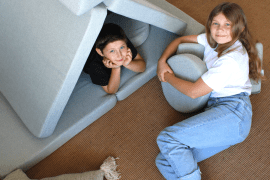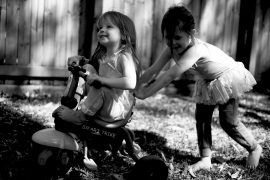By Rachel Schofield
“Mine!” screeches my 2 year old and I turn round to find him holding on tight to a Tonka truck. His 7-year-old brother has the other end and is pouting back, “No it’s not”. Undeterred my youngest tightens his grip and roars loudly. Then they are screaming in each other’s faces, tussling over the toy.
At moments like this I often feel a wave of embarrassment where I’m vaguely hoping that surely this time, one of my children will respond with the maturity of a well balanced adult and gracefully give his sibling the toy. And as hope of that quickly fades I feel an urge to fall into the pit with them and snatch the toy sneering something like, “If you can’t play nicely then neither of you can have it!”
In my endless quest to parent more compassionately, I’ve stumbled across insights that have given me far more realistic expectations about sharing. They offer a deep understanding about the big feelings that can get kicked up around sharing and in my better parenting moments these ideas even let me embrace squabbles over toys as opportunities to build connection.
How we think about sharing
One of my favorite pieces of writing on sharing comes from Heather Shumaker in her wonderful book It’s Okay Not to Share.
She points out how as adults we naturally take turns rather than share on demand. You’d likely feel really cross if your friend grabbed the book you were reading and said “I want it now, you’ve had it a really long time”, you’d expect her to wait until you’d finished. And this concept of waiting until ‘you’re all done’ works incredibly well for children too. It avoids the pitfalls of sharing that interrupt children’s play and encourages false generosity.
“Sure, you can have it when she’s finished with it” can be a relief to everyone. Children get to enjoy a toy for as long as they are interested in it which allows them to play more deeply and feel relaxed. It also opens up their sense of wanting to share by allowing them to choose when to pass it on and they then get to enjoy the feelings of being generous. Even very young children easily pick up on this and quickly come to adopt it in their own play. I’ll often hear my two year old say, “you have it when me finished”.
Younger children can easily be guided: “You can have it when Jack is finished. Jack can you let Lilly know when you’ve finished?” Or, “Are you finished with your turn? Oh she’s not done yet.” And older children can be encouraged to say, “I’m not done yet, you can have it when I’m finished.” Once older children get used to this, it helps them handle turn taking without needing adult support.
Of course there are also plenty of times when waiting for his turn is just too much for my two-year-old. Like with the Tonka truck. Then he needs more help.
Children love to share
It’s really helpful to remind ourselves how children are always doing their best; that they want to fit in, be part of their family and get on with their brothers and sisters. So when things are tough and their behavior flares, there are reasons for this. It’s good to notice how even very young children are quite capable of sharing toys and taking turns when they’re feeling good and connected. Sharing and turn taking seems to be an innate part of our social nature.
Listening to feelings
We can see that when children are struggling to share, it’s a big red flag that they have feelings getting in the way, blocking their natural instinct to give and take. Attachment theory research shows us that children depend on a sense of connection to the adults around them. Connection is vital. When that sense of connection breaks, feelings flood their mind making it hard to think well.
This lost sense of connection might come from feeling disconnected from their caregiver in the past few hours or because something has happened to remind them of stored hurt feelings inside which are now bubbling to the surface. It’s also possible that physical issues like thirst, hunger, allergies and digestive problems are behind their inner tension. Either way, they need us to connect with them.
It helps to move in close and listen to their upset. It might be tempting to try and fix things, to make them feel better, to try to reason with them or to get them thinking rationally and naming their feelings. But taking the time to slow down and simply be with them as they shed emotional tension is, in the long run, more helpful. Allowing a child to experience their emotions helps them to process those feelings at a body level, and this seems to be deeply healing.
When my 2-year-old was tugging at the Tonka truck screaming “It’s mine!”, I moved in, put my hand on his and mustered up as warm a voice as I could, “Yep, it’s yours and your brother is playing with it now. I’ll wait with you until he’s finished with it.” He kept holding tight to the truck and was shouting “No! No! No!” crossly. I just kept my hand on his and waited a little. Then I said again, “You can have it when he’s finished.” The anger gave way to tears and he let go of the toy and cuddled into me, still crying. I didn’t try to stop the tears, I just listened, gently offering eye contact. Pretty soon his big brother offered the truck back to him and he happily took it.
A child who is struggling to wait for their turn is helped enormously when we listen to their feelings. It seems to clear out the backlog of tension that was getting in the way of them waiting for their turn. Patty Wiplfer, founder of the not-for-profit Hand in Hand Parenting, calls the way we listen to children’s upsets “Staylistening”. She says that when a child begins to cry, storm or tantrum “[It] is constructive. It is your child’s way of getting rid of the tension that made her unreasonable in the first place. If you can stay close while she cries or storms, she will continue until she has regained her ability to listen, to be cooperative, and to make the best of the situation at hand.”
Listening to feelings also shifts our efforts away from “teaching” children to share and towards focusing on what’s stopping them from getting along well with each other. Targeting the cause of their behaviour rather than the surface level struggles.
“I’ll wait with you”
Other times a child might be helped just by having us wait with them. By staying close, we are offering ourselves and that tops up their vital need for connection.
Sometimes it’s useful to help a child think about what they might do whilst they are waiting, e.g. “Would you like to do this puzzle whilst you are waiting?” Children who are used to this “waiting until the other child is finished with” policy get very good at finding other things to do, and will often be able to come up with ideas.
See next page for more…











